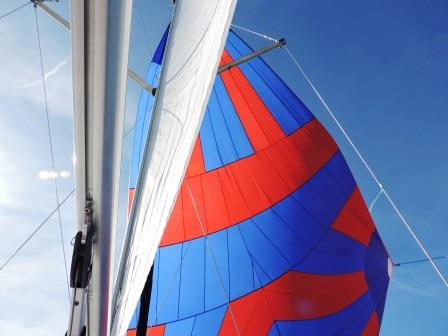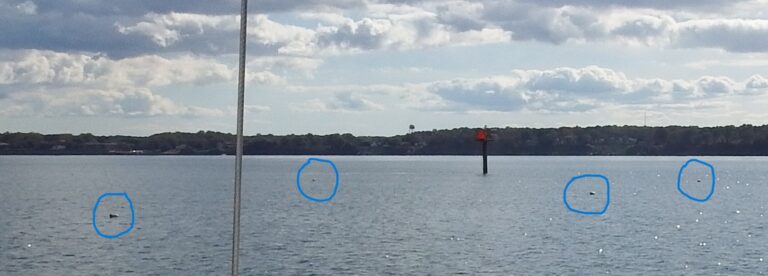For outdoor adventure while traveling to Williamsburg or Yorktown, nothing beats sailing on the York River. Here’s some advice on 19 ways to sail faster.
-
Read a primer such as “Sailing for Dummies” to get the idea. The illustrations show various angles of the wind on the boat. That’s the big deal. You’re positioning the boat to get the most impact from the wind. Therein lies the essence of sailing. That’s it, the rest is details.
-
Then read “Sailing: The Basics. The Book That has Launched Thousands.” There are many books on sailing, and one way to plow through them is one chapter at time followed by discussion with your sailing partner. It can be hard to imagine yourself in the particular setting of the instruction, but it makes your mind work on “seeing” the wind. That alone is a useful exercise, and meditative as well.
-
Focus on the chapters addressing the Reach of the wind. This is the heart of sailing. What you’re doing is moving the boat to achieve the best angle of the wind on the sails. Each reach has a specific effect on pulling or pushing the boat forward. Light winds obviously make the boat go slower than heavier winds, but each condition comes with its own set of experiences that are well worth learning. The American Sailing Association has a new app that simulates all the reaches. Use your phone to type in ASA app.
-
Study the Close Reach, as it builds and sustains the fastest speed. In light winds, keep the wind vane arrow just outside the V-shaped wire atop the mast. In heavier winds, move the arrow onto or just inside the V for top speed. The trick here is to “pinch” into the wind enough to maintain speed and momentum, but not too far or you’ll start to luff the jib. You’ll know that’s happening when the outside corner of the jib, called the clew, is barking at you. It means you have no clew.
-
Watch a YouTube video on the Close Reach (above). Note that the boat is heeling about 15 degrees, which is perfect. Don’t worry, the boat won’t tip over. A 4,000 lb. keel below the hull is the righting influence against the force of the sails. Note also that the foresail Genoa is shaped to show the wind’s effect. And note that the skipper is steering lightly, much like a car. No sharp turns or back-and-forth are required, until tacking into the wind.
-
Take an informal lesson for three hours to get the feel. That’s what Let’s Go Sail provides every day on the York River. Adults get the idea very quickly because they are immersed in the wind and the boat. They learn to identify the angle of the wind to achieve the desired 45 degrees off the windward wire.
-
Get out on the water, preferably with Let’s Go Sail. Or any competent instructor, preferably trained by the American Sailing Association. For a school near you, go to asa.com. The Basic Keelboat class runs Saturday and Sunday almost every weekend of the sailing season. Couples do well together because it becomes a team sport with division of duties. After an hour or two in the classroom, students go down to the dock and out on the water on a 22-foot Catalina Capri or similar boat. After two days of classroom and on-the-water instruction, students take a 100-question test of multiple choice answers to pass. Then you can sail the same ASA boats on your own.
-
Make sure the boat hull is clean, the sails new and taut. A clean hull is slick in the water. The slime that precedes barnacles would seem to be slick, but it’s actually a drag. Slime can slow down the boat by 2-4 mph, so it matters. New sails have a tight belly in the middle and thus exert maximum draft. Draft is the key to speed. Older sails get blown out in the middle although it isn’t always apparent. And some sails get stretched along the leech or the foot, exacerbating the draft distortion. If in doubt, ask an experienced sailor (better yet a racer) to take a look at your sails when hoisted. He or she can show you the soft spots.
-
Learn how to “find” the wind by filling the sails. Preferably achieving the Close Reach, or in heavier winds the Close Haul. In light winds, adjust the sails to be “puffy” so as to capture wind. In heavier winds, tighten the sails to spill wind that you don’t need. You’ll learn by experience to pinch the wind (see above) quickly. Look out on the water for dark spots; that’s wind. Soon you’ll feel the wind, and eventually feel gusts. Resist the temptation to come up into the wind and lose the effect. Try to steer through the gust to pick up speed and momentum. “Stay the course” is not just a political cliche, but rather a sailing maxim.
-
Move to a Close Reach and observe the sail positions. In a wind of 10 mph or greater, the main is fairly tight and perhaps 18 inches off center so as to spill wind. The gib or Genoa is wound down tight on the winch, with the clew close to the deck. In a wind less than 10 mph, the boom is only a foot or so off center and the main puffy to find and fill wind. Likewise, the jib clew rises up and out to find wind.
-
Using the sheets, get the boat heeling to 10-15 degrees. This is the optimum tilt. Anything less is either spilling too much wind or luffing. 20 degrees is okay for a few moments in a gust, but typically anything over 15 is inefficient and hard on the helmsman. It’s also uncomfortable for the crew as they try to jockey for a comfortable position while contemplating their mortality.
-
Sheet to a Close Haul to pinch in a strong wind. Try to find that sweet spot of 3-5 degrees of wind where the boat has momentum but isn’t going to luff. It’s tricky at first, but soon you’ll be seeing wind that you never saw before. Look at the white caps to see if they are greater or lesser than earlier and prepare to adjust accordingly to pinch. Be prepared to shift the boat if the wind changes course. Shift happens.
-
Execute Tacking turns quickly to switch the wind. First, be sure to avoid getting hit in the head or chest by the boom (hence the name). The boom will come across on its own, giving you time to focus on the Jib.
-
Turn the Jib Sheets efficiently to maintain momentum. Think of the metaphor of the bullfighter and the bull. He uses the cape to wave the bull through the run. Think of the wind as the bull. Let the wind do the work. Start with both hands on each sheet, still wound once or twice on the respective winch. When turning, keep the windward sheet tight and don’t let go until you’re directly in the wind. Quickly unravel the sheet on the winch. As the boat turns through the wind, quickly pull the new windward sheet on the winch and tighten. Voila.
-
Reef the sails if necessary to maintain control and speed. It’s best to reef at the dock because it’s safer than out on the water. Study the forecast for building winds and start with one reef in the main. If the boat has roller furling sails, you can wait until you get out on the water and unfurl only the appropriate amount of sail. Typically set two-third to four-fifths of the main in 10+ winds, and one-half of the jib.
-
After tacking upwind, turn 180 degrees to fly the Spinnaker. But only in light winds. The purpose of the Spinnaker is to mitigate the downwind run, which is notoriously slow on all sloop sailboats except in high winds. (If you experience high winds, you don’t need a spinnaker because you already have sufficient power to virtually surf home. Plus high winds can tear a Spinnaker, which is as thin as a parachute.)
-
But first, execute the Controlled Gybe as a safe turn. Tacking is turning into the wind for a smooth crossover of the main on the boom. Gybing is turning out of the wind and can snap the entire boom off the traveler unless controlled. To control gybe, pull in the main to almost straight and hold the lines while turning. The snap of the gybe will be softened this way. Then adjust the Jib, which is easy on a gybe.
-
Avoid the Lee as a dangerous downwind run. This is the classic wing-on-wing approach with the main out one side and the jib the other side. It looks elegant but is in fact quite dangerous. The wind is fluky, so an accidental Gybe can knock someone in the head and take him overboard. Absent that, an accidental Gybe can tear the equipment off the traveler, make it harder to get home. Watch any bad sailing mystery movie, and you’ll find they use an accidental Gybe to take out the antagonist by bonking him on the head and into the water. It’s a cheap way to end a movie, but it’s also a terrible way to do. Imagine a couple of college kids standing on the seat or the gunwales drinking beer when BAM! the boom knocks one or both into the water. Their first breath will be water, if indeed they have any breath at all. Hence the advice: Beware the boom, Beware the Lee.
-
Go flying home downwind in a straight line, exhilarating! And you’ll look terrific as well. Now you’re qualified to help any skipper set the spinnaker. I estimate that only one out of three sailboats have one, and only half of them fly it since it’s tricky and requires at least one other person (to run the helm).
-
Bonus point. Now that you know how to sail, you can take out boats on your own, with a captain. I recommend getmyboat.com as the best source for the most sailboats along the East Coast. For $300-$500 a half day, you can run the helm and test the waters of any size boat–and walk away without buying a boat. Alternatively, you can insinuate yourself at the local Wednesday night races to serve as crew. Again, you get to experience different boats under different weather conditions. You’ll also discover if racing is something you want to do. They say there are two types of sailors, racers and cruisers. Lastly, you can find yourself in demand by other sailors who need crew for the weekend. Again, no purchase is necessary. But you might want to show up with a six-pack as a courtesy.




